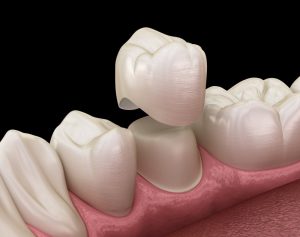
If you need a dental crown, you’re probably eager to get it. After all, the cap will protect and beautify your pearly white. Still, crown placement can’t actually be done immediately. Your local dentist will have to prepare your tooth for treatment first. (A crown won’t work otherwise.) As for what that prep work looks like, your Windermere dental practice is happy to explain. To that end, here’s how a dentist prepares a tooth for a crown.
1. They Perform an Oral Exam
First, the dentist needs to see if a crown suits your tooth. They’ll thus perform an oral exam at your initial consultation.
This exam will assess your pearly white for decay and damage. Therefore, it’ll likely include dental X-rays that offer a better view of your tooth roots. Based on what these images show, your dentist will decide whether to proceed with treatment.
2. They Remove Damaged Areas
Following the exam, the dentist will ready your tooth by removing its damaged portions. This process typically relies on a dental drill.
Contrary to what you’d think, such removal work is painless. Your dentist will have numbed your tooth beforehand with a local anesthetic. That way, their work won’t cause you any discomfort. The most you’ll feel is some slight pressure as the drill operates on your chomper.
3. They Clean & Fill the Tooth
After removing your tooth’s damaged areas, the dentist will clean and fill its newly formed empty spaces. Doing so is crucial to preventing future oral problems.
The cleaning step is relatively straightforward. Put simply, it removes harmful particles and disinfects the treated area. A tooth’s empty spaces can allow for bacteria growth, so these actions ensure nasty germs don’t hang around.
Once the empty spots are cleaned, the dentist fills them with gutta-percha. This material keeps bacteria out of the tooth, greatly reducing your risk for new infections.
4. They Smooth Things Out
Lastly, your dentist will finish the prep work by smoothing your tooth’s surfaces. That means they’ll shave and file down bits of the outer layer.
You see, a decayed or damaged tooth often has sharp sections. These can often harm your mouth by scraping or cutting oral tissues. Furthermore, said sections interfere with future crown placement. Your dentist will thus smooth them out to ensure the final prosthetic fits well and blends with your smile.
Ultimately, how a dentist prepares a tooth for a crown is vital. That being the case, remember the steps above so you can go into treatment confidently.
About the Practice
Windermere Dentistry is based in Windermere, FL. Led by Drs. Matthew McKissock and Rupal Thakkar, our practice strives to give each patient personalized dental care. We thus offer preventive, cosmetic, and restorative services tailored to your smile. Naturally, that means our dental crowns are some of the best around and boast excellent results! For more information or to book a visit, you can reach us on our website or by phone at (407)-909-1099.
